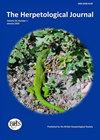蛇与永恒之城:意大利罗马郊区对比景观中蛇的社区指标、体型和人口密度的变化
IF 1.1
4区 生物学
Q3 ZOOLOGY
引用次数: 0
摘要
关于全球动物数量下降的报告现在很多,其中也包括蛇,这是一种现在被广泛视为生物指标的动物。任何保护或恢复蛇种群的保护管理计划的先决条件都需要一个能够深入了解种群组成和变化的数据库。然而,众所周知,蛇由于其隐秘和难以捉摸的性质,特别难以定量采样,因此积累足够的数据库进行分析需要长期的实地研究,包括密集的搜索。已经监测了四种蛇的种群,即Zamensis longissimus、Natrix helvetica、Vipera aspis和Hierophis viridiflavus,它们生活在罗马的两个郊区,栖息地发生了不同程度的变化(森林砍伐),Vejo是一个变化较小的地点,Tor Bella Monaca是一个高度变化的地点,但自1995年以来一直处于中断状态。结果表明,在这两个地点,绿色二黄酮是最常见的物种。在所有四个物种中都发现了雄性偏好,尤其是在最长叶蝉和肉冻叶蝉中,在绿色叶蝉和helvetica中检测到的幼体最多。在这两个研究地点都存在的H.viridiflavus和Z.longissimus的鼻孔到通风口的长度(SVL)在两个研究地区退化程度较低的栖息地更大。群落指标表明,退化栖息地的物种丰富度、均匀度、Shannon和Simpson多样性指数较低,但优势度指数较高。在Vejo,一次或多次被捕获的蛇的捕获频率通常更高。种群密度最高的是绿色黄曲霉,其次是阿斯皮氏黄曲霉和赫尔维蒂卡黄曲霉,两者相似。然而,密度的长期趋势显示,1995年至2019年间,A.aspis和N.helvetica的密度有所下降。种群密度与之前对更自然栖息地的蛇的研究中发现的密度估计值非常一致。本文章由计算机程序翻译,如有差异,请以英文原文为准。
Snakes and the Eternal City: variation in community metrics, body size and population density of snakes in contrasted landscapes of suburban Rome (Italy)
Reports of global declines in animal populations are now numerous and also include snakes, a group of animals now widely regarded as bio indicators. A prerequisite for any conservation management plan to protect or restore snake populations requires a data base that provides insight into population composition and changes. However, snakes are well known to be particularly difficult to quantitatively sample due to their secretive and elusive nature, and hence accumulating an adequate database for analysis requires long-term field studies that involve intensive searches. Populations of four snake species, Zamensis longissimus, Natrix helvetica, Vipera aspis and Hierophis viridiflavus living in two suburban areas of Rome with different extents of habitat alteration (deforestation), Vejo, a less altered site, and Tor Bella Monaca, a high altered site, have been monitored, but with interruptions since 1995. The results indicated that H. viridiflavus was the commonest species at both sites. Male bias was found in all four species but especially in Z. longissimus and V. aspis with detection of juveniles greatest in H. viridiflavus and N. helvetica. Snout to vent lengths (SVL) of H. viridiflavus and Z. longissimus, which were present at both sites, were greater at the less degraded habitat of the two study localities. Community metrics indicated that the degraded habitat had lower species richness, evenness, Shannon and Simpson diversity indices, but a higher dominance index. Recapture frequencies of snakes recaptured either once or multiple times were in general greater at Vejo. The highest population densities were found in H. viridiflavus, followed by V. aspis and N. helvetica, which were similar. However, long term trends in densities show declines in V. aspis and N. helvetica between 1995 and 2019. Population densities were in good agreement with density estimates found in previous studies of snakes in more natural habitats.
求助全文
通过发布文献求助,成功后即可免费获取论文全文。
去求助
来源期刊

Herpetological Journal
生物-动物学
CiteScore
2.40
自引率
10.00%
发文量
25
审稿时长
>12 weeks
期刊介绍:
The Herpetological Journal is the Society''s prestigious quarterly scientific journal.
 求助内容:
求助内容: 应助结果提醒方式:
应助结果提醒方式:


